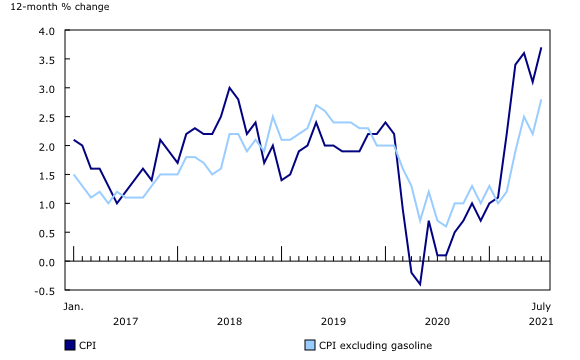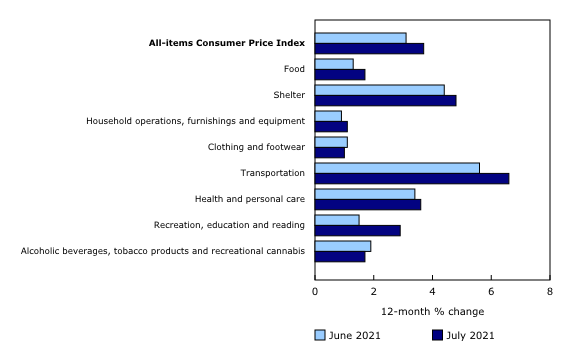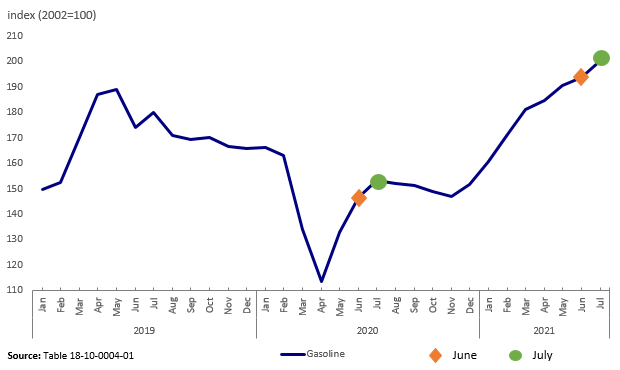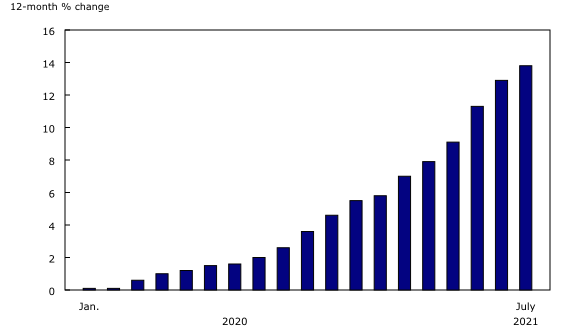Consumer Price Index, July 2021
Archived Content
Information identified as archived is provided for reference, research or recordkeeping purposes. It is not subject to the Government of Canada Web Standards and has not been altered or updated since it was archived. Please "contact us" to request a format other than those available.
Released: 2021-08-18
July 2021
3.7% 
(12-month change)
The Consumer Price Index (CPI) rose 3.7% on a year-over-year basis in July, up from a 3.1% gain in June. Excluding gasoline, the CPI increased 2.8% year over year.
On a monthly basis, the CPI rose 0.6% in July, the fastest pace since January 2021. On a seasonally adjusted monthly basis, the CPI was up 0.5%.
Highlights
Prices rose at a faster pace year over year in six of the eight major components in July, with shelter prices contributing the most to the all-items increase. Conversely, prices for clothing and footwear as well as alcoholic beverages, tobacco products and recreational cannabis slowed on a year-over-year basis in July compared with June.
Gasoline prices rise at a slower pace
Year over year, prices for gasoline rose less in July (+30.9%) than in June (+32.0%). A base-year effect continued to impact the gasoline index, as prices in July 2020 increased 4.4% on a month-over-month basis when many businesses and services reopened.
In July 2021, gasoline prices increased 3.5% month over month, as oil production by OPEC+ (countries from the Organization of Petroleum Exporting Countries Plus) remained below pre-pandemic levels though global demand increased.
Homeowners' replacement cost index rises at its fastest rate since 1987
The homeowners' replacement cost index, which is related to the price of new homes, continued to trend upward, rising 13.8% year over year in July, the largest yearly increase since October 1987.
Similarly, the other owned accommodation expenses index, which includes commission fees on the sale of real estate, was up 13.4% year over year in July.
Spotlight on food prices
Given that food is a frequently purchased good, high prices are often the subject of discussion, as are great deals. The price of food is influenced by a number of factors. Weather, for example, is the most important variable for maintaining the supply of crops. As farmers weather the elements, prices will reflect a good harvest or the lower supply that comes with a poor harvest. This was experienced in 2019, when lower vegetable yields were partly attributable to an El Niño climate pattern.
The COVID-19 pandemic has also influenced food prices in Canada. As restaurants closed for extended periods in some parts of the country, overall demand changed. Canadians consume different foods at restaurants than at home. For example, this shift led to a temporary over supply of potatoes for French fries early in the pandemic. Suppliers also had to adapt, in some cases shifting products destined for restaurants to grocery stores.
In the Consumer Price Index (CPI), food is the second-most important component by basket weight, representing 16.24% of the 2020 CPI basket. The food component is broken down into two categories: food purchased from stores (11.74% of the basket) and food purchased from restaurants (4.50%).
Overall food prices increased in July 2021 (+1.7%) compared with July 2020. Prices for food purchased from restaurants grew by 3.1%, the highest increase since January 2019, mainly driven by food purchased from fast food and take-out restaurants (+3.3%). Food purchased from stores (+1.0%) also rose in July. Canadians consume a variety of different foods, which can result in large price changes that offset each other at the aggregate level. For instance, prices for meat (+3.1%) and dairy products (+3.5%) increased on a year-over-year basis in July, while prices for fresh vegetables (-7.5%) and fresh fruit (-0.6%) fell during the same period.
Statistics Canada will continue to monitor developments in food prices and the impact on consumer price inflation.
Prices for durable goods increase at a faster pace
Year-over-year price growth for goods rose at a faster pace in July (+5.0%) than in June (+4.5%), with durable goods (+5.0%) accelerating the most. The purchase of passenger vehicles index contributed the most to the increase, rising 5.5% year over year in July. The gain was partially attributable to the global shortage of semiconductor chips.
Prices for upholstered furniture rose 13.4% year over year in July, largely as a result of lower supply and higher input costs. The introduction of tariffs on upholstered furniture, first implemented in early May 2021, may also have contributed to the increase.
The video equipment index was up 4.8% year over year, mainly driven by higher prices for televisions.
Regional highlights
Year over year, prices rose at a faster pace in July than in June in every province.
Consumers in Alberta pay more for electricity
The price of electricity in Alberta rose 25.1% on a month-over-month basis, the largest monthly increase since July 2015. The movement is largely attributable to an increase in demand amid high summer temperatures in the province.
Traveller accommodation prices increase the most in Newfoundland and Labrador
The traveller accommodation index rose 7.4% year over year in July, after falling 3.1% the previous month. Prices in Newfoundland and Labrador (+14.8%) increased the most, as the province lifted its non-essential travel ban that had been in place for nearly 14 months. Consumers in Quebec (+10.3%) and British Columbia (+10.0%) also paid more for traveller accommodations in July.
Note to readers
COVID-19 and the Consumer Price Index
Goods and services in the Consumer Price Index (CPI) that were not available to consumers in July due to COVID-19 restrictions received special treatments, effectively removing their impact on the monthly CPI. The following sub-indexes were imputed from the monthly change in the all-items index: travel tours, components of spectator entertainment, recreational services, and some components of use of recreational facilities and services in some areas.
Air transportation received the same treatments as in June.
The details of the treatments from April 2020 to March 2021 are provided in technical supplements available through the Prices Analytical Series. Details and other treatment information for April 2021 to July 2021 are available upon request.
As COVID-19 restrictions ease throughout the country, products and services that were unavailable for consumption in previous months will start to become available. Statistics Canada continues to monitor the impacted sectors and will remove these special treatments and reintroduce monthly pricing as the goods and services become widely available for consumption.
Explore the Consumer Price Index
Check out the Personal Inflation Calculator! This interactive calculator allows you to enter dollar amounts in the common expense categories to produce a personalized inflation rate, which you can compare to the official measure of inflation for the average Canadian household—the Consumer Price Index (CPI).
Visit the Consumer Price Index portal to find all CPI data, publications, interactive tools, and announcements highlighting new products and upcoming changes to the CPI in one convenient location.
Check out the Consumer Price Index Data Visualization Tool to access current and historical CPI data in a customizable visual format.
Real-time data tables
The real-time data table (18-10-0259-01) will be updated on August 30. For more information, consult the document "Real-time tables."
Next release
The CPI for August will be released on September 15, 2021.
Products
The "Consumer Price Index Data Visualization Tool" is available on the Statistics Canada website.
More information on the concepts and use of the Consumer Price Index (CPI) is available in The Canadian Consumer Price Index Reference Paper (62-553-X).
For information on the history of the CPI in Canada, consult the publication Exploring the First Century of Canada's Consumer Price Index (62-604-X).
Two videos, "An Overview of Canada's Consumer Price Index (CPI)" and "The Consumer Price Index and Your Experience of Price Change," are available on Statistics Canada's YouTube channel.
Contact information
For more information, or to enquire about the concepts, methods or data quality of this release, contact us (toll-free 1-800-263-1136; 514-283-8300; STATCAN.infostats-infostats.STATCAN@canada.ca) or Media Relations (613-951-4636; STATCAN.mediahotline-ligneinfomedias.STATCAN@canada.ca).
- Date modified:







